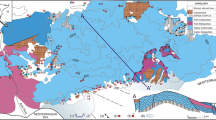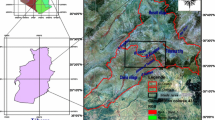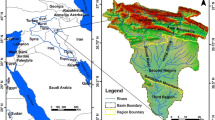Abstract
Defining groundwater circulation velocity and residence time in the karst is of particular importance, especially for purposes of water supply use. Investigations were performed at Veliko Vrelo and Malo Vrelo springs, which are typical gravitational circulation karst springs of the Beljanica massif, for determining groundwater residence time, both during the high-flow period, which is characterized by rapid water circulation (spring period), as well as in the recession period (end of summer) when water circulates significantly more slowly through smaller and relatively deeper karst channels. For purposes of defining the different groundwater residence times and circulation velocity, besides tracer test (Na-fluorescein), stable isotope methods 18O, 2H, 13C as well as radioactive isotopes 3H and 3H + 3He were used. Additionally, to determine the temperature conditions that prevail, as well as recharge duration in the vadose zone during the groundwater recharge period, the content of noble gases in groundwater was measured. The results reveal the dual development of karst conduits, where the first circulation zone is characterized by larger channel dimensions where groundwater rapidly circulates over a period of only several days, while the second zone consists of smaller channels and cracks, in which the waters reside 3 or 4 months during the recession period.







Similar content being viewed by others
References
Milanović S (2010) Formiranje fizičkog modela karstne izdani na primeru Beljanice (istočna Srbija), Doktorska disertacija, Departman za hidrogeologiju, Rudarsko-geološki fakultet, Beograd
Milanović S, Stevanović Z, Vasić LJ (2010) Monitoring podzemnih voda Beljaničkog masiva u funkciji formiranja modela karstnog sistema. Vodoprivreda 42:246–248 (0350-0519, 199-212)
Milanović S, Vasić LJ, Kličković M (2012) Formiranje 3D modela karstnih kanala u zoni isticanja vrela kao podloga za zahvatanje podzemnih voda u karstu – na primeru Malog vrela. Vodoprivreda 44:258–260 (0350-0519, 169–173)
Palcsu L, Major Z, Köllő Z, Papp L (2010) Using an ultrapure 4He spike in tritium measurements of environmental water samples by the 3He-ingrowth method. Rapid Commun Mass Spectrom 24:698–704
Papp L, Palcsu L, Major Z, Rinyu L, Toth I (2012) A mass spectrometric line for tritium analysis of water and noble gas measurements from different water amounts in the range of microlitres and millilitres. Isot Environ Health Stud 48(4):494–511
Stevanović Z (1981) Hidrogeološke karakteristike karsta Kučajsko-beljaničkog masiva sa aspekta mogućnosti korišćenja izdanskih voda za vodosnabdevanje, Magistarski rad, Departman za hidrogeologiju, Rudarsko-geološki fakultet, Beograd
Stevanović Z (1991) Hidrogeologija karsta Karpato-balkanida istočne Srbije i mogućnosti vodosnabdevanja, monografija. DHG-RGF, Beograd
Vasić LJ (2017) Geneza i uslovi cirkulacije voda kompleksnih karstnih sistema Kučajsko-beljaničkog masiva, Doctoral dissertation, Department of hydrogeology, Faculty of mining and geology, University of Belgrade, Belgrade
Vasić LJ, Milanović S (2018) Determination of groundwater circulation velocity of karst springs with gravitational circulation by isotope and noble gas method - case study of Veliko vrelo and Malo vrelo springs of Beljanica massif. In: Proceedings of the international symposium KARST 2018 "Expect the Unexpected", Trebinje, Faculty of Mining and Geology, University of Belgrade, pp 231–237
Acknowledgements
Research presented in this paper was supported by projects from the Ministry of Education, Science and Technological Development, Republic of Serbia: Project No. OI 176022 (“Groundwater Potential and Base for its Sustainable Utilization”) and Project No. TR 37005 (“Assessment of climate change impact on Serbia’s water resources”).
Author information
Authors and Affiliations
Corresponding author
Additional information
Publisher's Note
Springer Nature remains neutral with regard to jurisdictional claims in published maps and institutional affiliations.
This article is a part of a Topical Collection in Environmental Earth Sciences on Sustainable Management of Karst Natural Resources, guest edited by Drs. Sasa Malinovic and Zoran Stevanovic.
Rights and permissions
About this article
Cite this article
Vasić, L., Palcsu, L. & Fen, H. Groundwater gravitational circulation of Karst Veliko Vrelo and Malo Vrelo springs by isotope and the noble gas method: case study of the Beljanica Massif. Environ Earth Sci 78, 307 (2019). https://doi.org/10.1007/s12665-019-8294-0
Received:
Accepted:
Published:
DOI: https://doi.org/10.1007/s12665-019-8294-0




